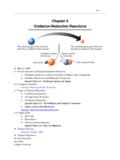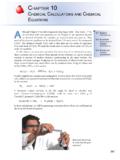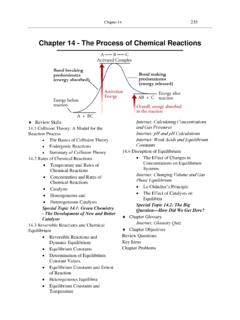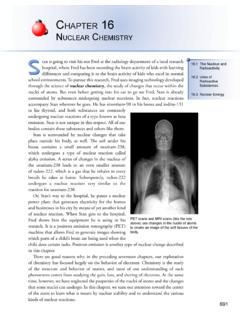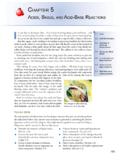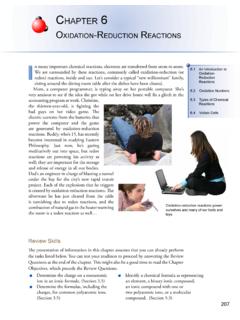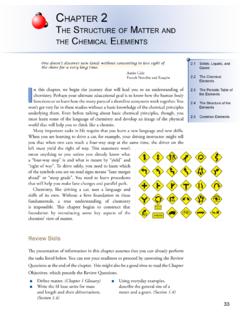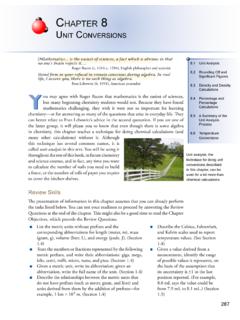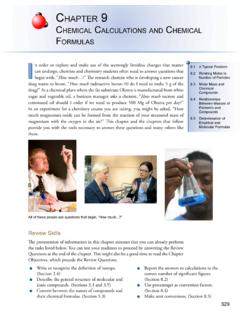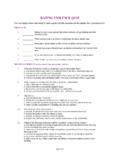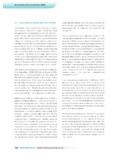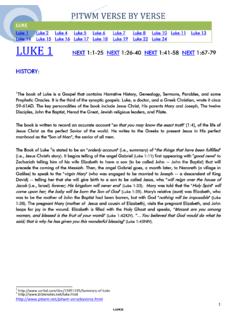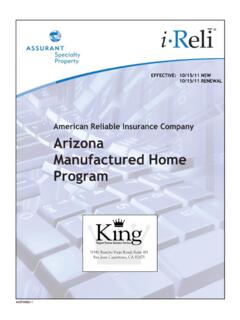Transcription of Chapter a I to ChemICal reaCtIons - Mark Bishop
1 Chapter 4an IntroduCtIon to ChemICal reaCtIons125ow that you understand the basic structural differences between different kinds of substances, you are ready to begin learning about the ChemICal changes that take place as one substance is converted into another. ChemICal changes are chemists primary concern. They want to know what, if anything, happens when one substance encounters another. Do the substances change? How and why? Can the conditions be altered to speed the changes up, slow them down, or perhaps reverse them? Once chemists understand the nature of one ChemICal change, they begin to explore the possibilities that arise from causing other similar example, let s pretend that you just bought an old house as is, with the water turned off.
2 On moving day, you twist the hot water tap as far as it will go, and all you get is a slow drip, drip, drip. As if the lack of hot water weren t enough to ruin your day, you also have a toothache because of a cavity that you haven t had time to get filled. As a chemist in training, you want to know what ChemICal changes have caused your troubles. In this Chapter , you will read about the ChemICal change that causes a solid to form in your hot water pipes, eventually blocking the flow of water through them. In Chapter 5, you will find out about a ChemICal change that will dissolve that solid, and a similar change that dissolves the enamel on your teeth.
3 Chapter 5 will also show you how fluoride in your toothpaste makes a minor ChemICal change in your mouth that can help fight changes, like the ones mentioned above, are described with ChemICal equations. This Chapter begins with a discussion of how to interpret and write ChemICal ChemICal reaCtIons and ChemICal Solubility of Ionic Compounds and Precipitation ReactionsReview SkillsThe presentation of information in this Chapter assumes that you can already perform the tasks listed below. You can test your readiness to proceed by answering the Review Questions at the end of the Chapter .
4 This might also be a good time to read the Chapter Objectives, which precede the Review Questions. Write the formulas for the diatomic elements. (Section ) Predict whether a bond between two atoms of different elements would be a covalent bond or an ionic bond. (Section ) Describe attractions between H2O molecules. (Section ) Describe the structure of liquid water. (Section ) Convert between the names and formulas for alcohols, binary covalent compounds, and ionic compounds. (Sections )A ChemICal reaction causes solids to form in hot water pipes. ChemICal reaCtIons and ChemICal EquationsA ChemICal change or ChemICal reaction is a process in which one or more pure substances are converted into one or more different pure substances.
5 ChemICal changes lead to the formation of substances that help grow our food, make our lives more productive, cure our heartburn, and much, much more. For example, nitric acid, HNO3, which is used to make fertilizers and explosives, is formed in the ChemICal reaction of the gases ammonia, NH3, and oxygen, O2. Silicon dioxide, SiO2, reacts with carbon, C, at high temperature to yield silicon, Si which can be used to make computers and carbon monoxide, CO. An antacid tablet might contain calcium carbonate, CaCO3, which combines with the hydrochloric acid in your stomach to yield calcium chloride, CaCl2, water, and carbon dioxide.
6 The ChemICal equations for these three ChemICal reaCtIons are below. NH3(g) + 2O2(g) HNO3(aq) + H2O(l)SiO2(s) + 2C(s) Si(l) + 2CO(g)CaCO3(s) + 2 HCl(aq) CaCl2(aq) + H2O(l) + CO2(g)2000 COnce you know how to read these ChemICal equations, they will tell you many details about the reaCtIons that take a ChemICal EquationIn ChemICal reaCtIons , atoms are rearranged and regrouped through the breaking and making of ChemICal bonds. For example, when hydrogen gas, H2(g), is burned in the presence of gaseous oxygen, O2(g), a new substance, liquid water, H2O(l), forms. The covalent bonds within the H2 molecules and O2 molecules break, and new covalent bonds form between oxygen atoms and hydrogen atoms (Figure ).
7 Figure Formation of Water from Hydrogen and Oxygen+hydrogen + oxygen water ese covalent bonds covalent bonds numbers and kinds of atoms on each side of the arrow e atoms are Chapter 4 An Introduction to ChemICal ReactionsChemical changes lead to the formation of substances that help grow our food, make our lives more productive, and cure our heartburn. ChemICal reaCtIons and ChemICal Equations 127A ChemICal equation is a shorthand description of a ChemICal reaction. The following equation describes the burning of hydrogen gas to form liquid water.
8 2H2(g) + O2(g) 2H2O(l) ChemICal equations give the following information about ChemICal reaCtIons . ChemICal equations show the formulas for the substances that take part in the reaction. The formulas on the left side of the arrow represent the reactants, the substances that change in the reaction. The formulas on the right side of the arrow represent the products, the substances that are formed in the reaction. If there are more than one reactant or more than one product, they are separated by plus signs. The arrow separating the reactants from the products can be read as goes to or yields or produces. The physical states of the reactants and products are provided in the equation.
9 A (g) following a formula tells us the substance is a gas. Solids are described with (s). Liquids are described with (l). When a substance is dissolved in water, it is described with (aq) for aqueous, which means mixed with water. The relative numbers of particles of each reactant and product are indicated by numbers placed in front of the formulas. These numbers are called coefficients. An equation containing correct coefficients is called a balanced equation. For example, the 2 s in front of H2 and H2O in the equation we saw above are coefficients. If a formula in a balanced equation has no stated coefficient, its coefficient is understood to be 1, as is the case for oxygen in the equation above (Figure ).
10 Figure ChemICal Equation for the Formation of Water from Hydrogen and OxygenobjeCtIve 3objeCtIve 2 If special conditions are necessary for a reaction to take place, they are often specified above the arrow. Some examples of special conditions are electric current, high temperature, high pressure, and light.+"Goes to"2H2(g) + O2(g) 2H2O(l)Physical stateCoefficientCoefficientPhysical statesThe burning of hydrogen gas must be started with a small flame or a spark, but that is not considered a special condition. There is no need to indicate it above the arrow in the equation for the creation of water from hydrogen and oxygen.
